Influences….
Rachel Whiteread…..
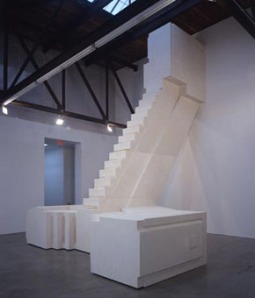 British artist Rachel Whiteread is best known for her sculptures which typically take on the forms of casts, and she was the first female artist to win the Turner Prize.
British artist Rachel Whiteread is best known for her sculptures which typically take on the forms of casts, and she was the first female artist to win the Turner Prize.
Many of Whiteread’s works are casts of ordinary domestic objects, and in most cases the space the objects do not inhabit,often termed the “negative space”, instead producing a solid cast of where the space within a container would be.. particular parts of rooms, the area underneath furniture and so on. She says the casts carry “the residue of years and years of use”.
The Poetics Of Space – Gaston Bachelard…..
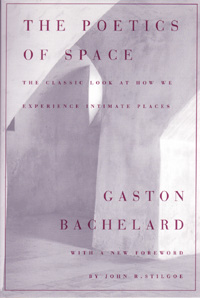
The Poetics of Space is a book by Gaston Bachelard published in 1958. Bachelard applies the method of phenomenology to architecture basing his analysis not on purported origins (as was the trend in enlightenment thinking about architecture) but on lived experience of architecture. He is then led to consider spatial types such as the attic, the cellar, drawers and the like. This book implicitly urges architects to base their work on the experiences it will engender rather than on abstract rationales that may or may not affect viewers and users of architecture.
It’s really amazing! It looks at how we experience intimate places, and takes us on a journey, from cellar to attic, it shows how our perceptions of houses and the spaces in them shape our thoughts, memories and dreams…quite arty farty, but it’s a really enjoyable book, and im sure it’ll help me with my project.
Ceal Floyer…..
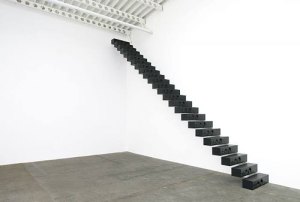
This is an Installation piece by Ceal Floyer of a staircase of speakers playing the sound of footsteps. Really simple but so effective which is what I would like to appropriate for my piece.
Ceal Floyer’s clarity of thought and the elegantly concise presentation of her ideas resonate through all areas of her practice. The deceptive simplicity of the work is informed by Floyer’s particular sense of humour and an awareness of the absurd; her use of double-takes and shifting points of view forces the viewer to renegotiate his perception of the world. Floyer often uses everyday or readymade objects, exploring the dialectical tension between the literal and the mundane, and an imaginative construction of meaning.
Sarah Sze….
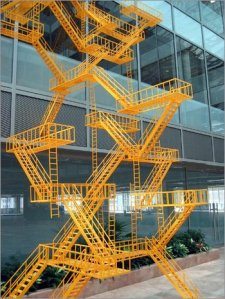
Sze’s sculptures are flowing structures consisting of an abundance of small-scale household items that respond to and infiltrate the surrounding architecture. Like the information flow of the World Wide Web, her compositional language takes form by successively linking small bits of discrete information into a complex network. With an intensity born of a laborious patchwork technique that is at once painterly and sculptural, the interplay between individual components and overall structure allows Sze to explore the boundaries between art and everyday life.
Simon Woolham….
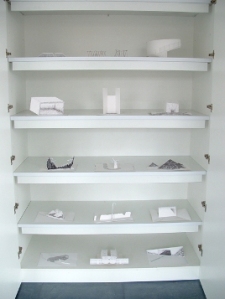
He is concerned primarily with occupied spaces and the personal and shared narratives that unfold in them. His drawings of school playing fields, junked underpasses and the like often contain text with the tone of dialogue. Through these glimpses of speech the dilapidated environments come to life in a skint version of enchantment: a tree stump or a broken fence are filled with the meanings of the events that go on around and about them.
In his attempts to unearth this unpredictable and fragile process of memory, for the show at Bloc he will use biro drawings, model interventions, animation, video and text that focus on recurring motives in his work: ditches, unofficial dumps, breached security fences. His work is unassuming, quite often made from simple materials and with seemingly modest aspirations. It is their quotidian qualities, however, that charges them with emotion, not that those emotions are easy to identify.
Janet Cardiff….
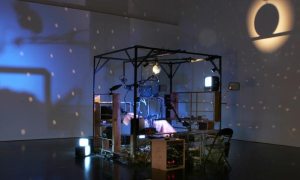
Cardiff’s installations and walking pieces are often audio-based. Janet Cardiff’s work depends on the active participation of the viewer /participant for its full realisation. The voice of the artist and scenes taped in the library are layered onto the visitor’s actual experience of moving through the physical environment of the library. Cardiff confounds our sensory perception and consequently our ability to perceive reality. The experiential nature of her work allows a more direct connection with the artwork than is typical in a museum. In selecting the library as the location of her work, Cardiff explores our relationship to books, another medium through which our imagination can be transported through time and place in the pursuit of alternative realities.






leave a comment